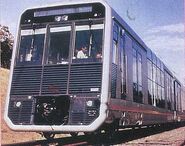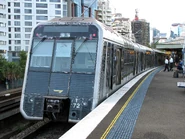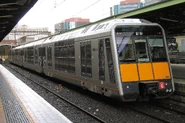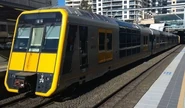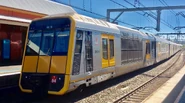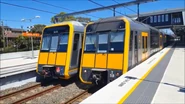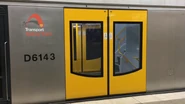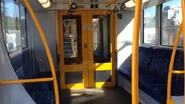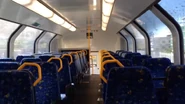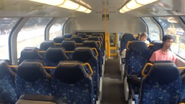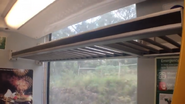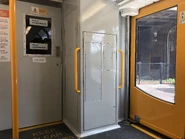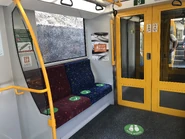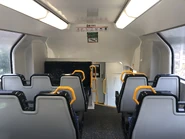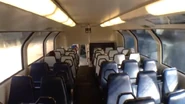The T Set (commonly known as the ‘Tangara’) is a class of electric multiple unit (EMU) operated by Sydney Trains. Its name originates from an Aboriginal word that means ‘to go’. Tangara sets entered service between 1988 and 1995 as the third-generation of metropolitan rolling stock.
Two subclasses were commissioned – T-sets for suburban operations and G-sets for outer-suburban operations.
A total of 450 carriages were ordered, with five additional driving trailers built in 1996 to replace damaged cars. All Tangara carriages were manufactured by Goninan.
Design[]
The carriages are in a D-N-N-D configuration where D is a driving pantograph trailer and N is a non-control motor car. The G-sets used a similar configuration OD-ON-ONL-OD, however they used separate letters as they had differences in interior layout (toilet in third carriage).
Many new features introduced by the Tangara, such as chopper control and regenerative braking, were trialled by the preceding C Set trains. T-sets are the first generation to have many standard features on current trains, such as covered gangways and the D-N-N-D configuration.
Unlike most members of the fleet, the Tangaras have triple-glazed windows (except for the doors, which have double-glazed windows) which are constructed from three separate layers of glass. The outer layer is more fragile compared to the thicker layer on the side facing inside the carriage, allowing for extra protection of passengers.
A new seating design was introduced with the Tangaras. Benches were moulded into 2 or 3 separate seats, allowing for more focused posture support and improved cushioning. This configuration also decreases maintenance costs as vandalised chairs can be replaced individually, instead of the entire bench.
A consequence of this design is the lack of seat reversibility present in preceding models. Instead, seats are fixed in position, with the front half of a carriage facing forward and the other half facing backward. The T-set seats originally had fabric upholstery, but were gradually converted to blue vinyl upholstery, before getting fitted with new moquette (same as on 4th generation trains) in the 2010-2014 interior refurbishments.
The Tangaras are suitable for lines with a medium width classification or higher, being 3000mm wide with doors closed and 3168mm wide with doors open on both sides.
T Set[]
With 370 carriages, the standard T-sets are one of the most common models in the Sydney Trains fleet. The T-sets replaced the first generation of Sydney's electric rolling stock. The cars built were:
- Driving trailer cars - D6101-D6285
- Additional spare trailer cars - D6286-D6289
- Motor cars - N5101-N5285
T sets were originally fitted with passenger door release handles to prevent loss of air conditioning at stations. However, passenger inexperience with the boarding system resulted in its disablement and door control returning to the guard. Many T-sets retained the release handles, but were non-operational. These doors were then removed from 2014 onwards due to the rollout of the new lightweight plug doors. The C-sets were fitted with a similar system, using push buttons instead of handles.
Tangara carriages have a seated capacity of 98 passengers for driving trailer cars, and 112 for motor cars.
In Service[]
When the Tangara T-sets first entered service, they had black panels with grey stripes on the front of the driving trailer cars, with the State Rail "L7" logo on the bottom of the middle panel. On the bottom of the carriage sides, they had two stripes in State Rail's red and orange colours. They also originally had black passenger doors and dark blue fabric seating. After State Rail rebranded as CityRail, the Tangara fleet underwent the "Citydecker" refurbishment, which had the seating upholstery replaced with blue vinyl, and the State Rail red and orange colours was replaced by CityRail's blue and yellow. On the side of the carriages, between the upper and lower deck windows, are black panels with “TANGARA” written on them.
Around 2003, all Tangaras were updated with the new CityRail corporate appearance. This involved the fitting of yellow panels on the front, yellow painted passenger doors and the end carriages receiving yellow paint surround for the benefit of visually impaired passengers. Blue and yellow stripes along the bottom of the carriages were replaced by a single yellow stripe and new fuzzy CityRail logos were placed on the driving cars. After the formation of Sydney Trains in July 2013, the 2003 CityRail logos was replaced by the new Sydney Trains "hop" logo.
In 2010, a program to refresh the Tangara interiors (including the newly converted G-sets) was announced. T121 (ex G21) was the first set to undergo this refurbishment while undergoing its conversion to a T-set before being carried out to the rest of the fleet. The interior refurbishment and upgrades include reconfigured seating next to the vestibule area, new “Moquette” seating upholstery, new Treadmaster TM8 flooring, yellow vertical poles and ceiling handrails with grips, and "sunflower yellow" repainted gangway doors; as of 2014 this has been completed, with set T53 being the last set to be refurbished. These refurbishments were done to meet the standard of the fourth generation electric rolling stock, as well as improving passenger safety and comfort.
In October 2014, six Tangara T-sets trialled new lightweight passenger doors with windows shaped similar to the doors on the Millennium M-sets, but designed specifically for the T-sets’ plug door mechanism. The trial was successfully completed in early 2015, leading to the rest of the Tangara carriages being fitted with the new doors over a year and a half period, with the whole fleet being finished at the end of July 2016. These new doors were installed to improve safety and reliability, while the lack of panels underneath the windows prevents vandals from kicking them out. With the installation of the new doors, modifications were made to the hydraulic system, making the doors open and close more smoothly and with less force. The first set to receive the new doors was T96, followed by T33 and T64.
All the Tangara T-sets are based at the maintenance centres at Hornsby and Mortdale, with the colour of the target plate indicating which depot they are based at. Hornsby-based sets have black target plates, while the Mortdale-based sets have red target plates. Hornsby sets mostly run Sector 3 (T1 North Shore and Western Lines, and T9 Northern Line), while Mortdale sets mostly run Sector 1 (T4 Eastern Suburbs & Illawarra Line). Mortdale-based T-sets also previously ran Sector 2 services until 2013, when T-sets were withdrawn from said sector. Note that trains now frequently swap depots, as several Sector 1 T-sets are scheduled to stable in Sector 3 and vice versa. Tangaras may occasionally operate on other lines if needed, as all Sydney Trains drivers are qualified to operate T-sets.
Standard suburban T-sets are numbered T1-T54, T57-T65, T67-T81, T83, T86 and T88-T99, while the former outer-suburban G-sets were renumbered as set numbers T100-T110, T121-T122 and T125-T130. Sets T1-T54, T100-T110 and T121 are based at Mortdale (red target plates) and sets T57-T65, T67-T81, T83, T86, T88-T99, T122 and T125-T130 are based at Hornsby (black target plates).
Tangara T-sets regularly operate on all Sydney trains lines except the T7 Olympic Park line.
After the S-sets ceased timetabled services on 28 June 2019, changes happened to operation duties on some lines. T-sets briefly took over weekday Lidcombe to Olympic Park shuttles as of 1 July 2019, until K-sets took over primary duties. Tangaras also operate some express services from Central to Olympic Park during special events.
G-sets[]
The last 80 of the 450 Tangara cars were built for use on South Coast, Blue Mountains and Central Coast peak hour services and were known as the outer-suburban G-sets. They entered service in 1994-1995, shortly after the delivery of the last T-set carriages. The G-sets have a similar external appearance to the T-sets - the only major differences are round green door buttons and a modified front with orange panels and bottom corners that taper inwards. Inside, the G-sets sported improvements over their T-set counterparts, such as high-backed reversible seats, toilets, fresh water dispensers and luggage racks. The G-sets were originally nicknamed "Odyssey" when first released. The cars built were:
- Driving Trailer Cars - OD6801-OD6841
- Motor Cars - ON5801-ON5820
- Motor Cars with Toilet - ONL5851-ONL5870
Set G7 was fitted with a 3-level IGBT–VVVF inverter drive system (supplied by Mitsubishi Electric) with AC motors[1] for evaluation purposes with the existing DC stock and compatibility with signalling and communication systems on the network. G7 was scrapped in 2005 at the Maintrain (now UGL Unipart) facility at Auburn after the 2003 Waterfall train disaster, as all four cars of G7 (OD6831, ON5816, ONL5866 and OD6832) were beyond repair. In late 2005 15 V Set carriages were suddenly withdrawn due to the discovery of corrosion in their underframes. G-sets began to operate more off-peak Intercity runs to Port Kembla, Kiama, and Wyong to cover for the withdrawn V sets. In 2003, the G-sets were fitted with the same current Sydney Trains corporate yellow livery as their T-set counterparts, and then from 2010-2014, underwent the same interior refurbishments as the rest of the fleet after their conversion to T-sets.
Redeployment to suburban services[]
In February 2003, a contract was awarded to United Group Rail (UGL) to construct 41 OSCAR H-set carriages (10 four car trains, plus 1 spare car). These new trains have a very similar level of passenger amenity to the G-sets and can be seen as a continuation of the design. In April 2005 an additional 81 carriages were ordered. The OSCARs started entering service in December 2006, leading to a change in the role of the G-sets. From 2007 the G-sets were progressively redeployed to suburban services, providing extra capacity on high demand existing services such as on the Western line and allowing new services to be introduced. By 2008, G-sets were often used on peak suburban services that extend into intercity areas, such as services to Springwood (via the Western line).
In 2009, the conversion of G-sets to T-sets began, to improve their suitability for suburban working as OSCAR sets continued to replace their interurban duties. Conversion work consisted of the removal of toilets with the water dispensers and their replacement with additional seating. Other work included the installation of new handrails and hangers and the recoding of cars and sets. Most sets were given a set number corresponding to their original G-set numbers (e.g. G25 becoming T125), though there are some exceptions (such as G11 becoming T107). Car numbers were retained, and only had the prefixes changed to D/N as appropriate. G4 was the first to be converted (into T104), while G5 (T105) was the last.
Tangara Technology Upgrade Program[]
These sets are currently undergoing their mid-life overhauls, also known as the Tangara Technology Upgrade Program. This upgrade is designed to help improve reliability, safety and passenger comfort, and is expected to keep the T-sets in regular service for at least another 10-20 years. Stage 1 of this project, which only involved the simple door replacement mentioned above, has been completed. Stage 2 will include replacement of obsolete, hard-to-replace parts and improvements to the passenger experience. The driving controls will be completed replaced with a new design incorporating ATP (automatic train protection) technology. Possibly to cut costs, after upgrade, each pair of sets will be semi-permanently coupled, with only shunting controls in the middle cabs. In the passenger cabin, CCTV and internal emergency door release are being installed. Passenger information displays were also being installed, but this feature has been cancelled due to problems. The contract for this phase of the project was awarded in 2015 to UGL Rail and Unipart.
In 2016, set T106 (ex G6) was brought to the UGL Goninan facility at Broadmeadow to allow detailed designs to be made for the upgrade, before being transferred to UGL Unipart at Auburn five months later to have the new features fitted. The second set chosen to undergo the upgrade, T72, was then delivered to UGL Unipart, but it was discovered that the two sets were wired differently (as T106 is a ex G-set, while T72 is a standard T-set), causing the project to undergo another revision.
It was announced in 2019 that a third stage has been added to fit the trains with ATP (automatic train protection), as recommended after the Waterfall train disaster in 2003.
On 11 May 2019, T106 and T72 underwent their first tests for the new features installed as part of the project. Due to the delays to the project, it was planned to accelerate the project by upgrading 4-sets (16 cars) at a time. Accordingly, T76 and T128 were taken out of service for their upgrade, with rosters shuffled around to cover for the missing 8 car set. As of August 2021, neither set has re-entered service. The project is rumoured to be now indefinitely on hold after running into difficulties, with UGL released from their contract.
As of October 2021, changes were made to the rollout of the upgrade, with the planned internal passenger information screens and upgraded destos delayed from the project. Destination indicators are installed in the upgraded sets, but are so far not connected. Sets will be upgraded progressively to receive the new Emergency Help Points, red priority seating and extended handrails next to the doors. On 12 November 2021, T52 and T73 were the first sets to re-enter service with the new features. Other sets are currently in the process of receiving the upgrades.
Numbering[]
Sets and carriage numbers are listed as below. Standard T-sets are numbered D61xx/D62xx and N51xx/N52xx, and ex G-sets are numbered D68xx and N58xx.
| Set No. | Driving Car | Motor Car | Motor Car | Driving Car | Notes |
|---|---|---|---|---|---|
| T 1 | D 6105 | N 5105 | N 5106 | D 6106 | D6106 was replaced by D6148 following an accident but it was repaired and put back on T1. |
| T 2 | D 6119 | N 5119 | N 5141 | D 6141 | |
| T 3 | D 6253 | N 5253 | N 5254 | D 6254 | |
| T 4 | D 6136 | N 5136 | N 5137 | D 6137 | |
| T 5 | D 6118 | N 5118 | N 5140 | D 6140 | |
| T 6 | D 6175 | N 5175 | N 5146 | D 6176 | |
| T 7 | D 6191 | N 5191 | N 5192 | D 6192 | |
| T 8 | D 6217 | N 5217 | N 5218 | D 6218 | |
| T 9 | D 6219 | N 5219 | N 5220 | D 6220 | |
| T 10 | D 6221 | N 5221 | N 5222 | D 6222 | |
| T 11 | D 6163 | N 5163 | N 5164 | D 6164 | |
| T 12 | D 6247 | N 5247 | N 5248 | D 6248 | |
| T 13 | D 6252 | N 5249 | N 5250 | D 6250 | D 6249 -> D 6252 - see below
ATP test set until July 2019 |
| T 14 | D 6251 | N 5251 | N 5854 | D 6808 | N 5252 -> N5854, D 6252 -> D 6808 - see below |
| T 15 | D 6239 | N 5239 | N 5240 | D 6240 | |
| T 16 | D 6108 | N 5241 | N 5242 | D 6242 | D 6241 -> D 6108 - see below |
| T 17 | D 6243 | N 5243 | N 5244 | D 6244 | |
| T 18 | D 6121 | N 5121 | N 5122 | D 6122 | |
| T 19 | D 6146 | N 5176 | N 5285 | D 6285 | N 5127 -> N 5285, D 6127 -> D 6285 - see below |
| T 20 | D 6101 | N 5101 | N 5102 | D 6102 | First four T set carriages built |
| T 21 | D 6120 | N 5120 | N 5142 | D 6142 | |
| T 22 | D 6109 | N 5109 | N 5112 | D 6112 | |
| T23 | D 6177 | N 5177 | N 5178 | D 6178 | |
| T 24 | D 6147 | N 5147 | N 5148 | D 6289 | D 6148 -> D 6289 - see below |
| T 25 | D 6149 | N 5149 | N 5150 | D 6150 | |
| T 26 | D 6151 | N 5151 | N 5152 | D 6152 | |
| T 27 | D 6125 | N 5125 | N 5126 | D 6126 | |
| T 28 | D 6155 | N 5155 | N 5156 | D 6156 | |
| T 29 | D 6157 | N 5157 | N 5158 | D 6158 | |
| T 30 | D 6159 | N 5159 | N 5160 | D 6160 | |
| T 31 | D 6161 | N 5161 | N 5162 | D 6162 | |
| T 32 | D 6167 | N 5167 | N 5168 | D 6168 | |
| T 33 | D 6165 | N 5165 | N 5166 | D 6166 | |
| T 34 | D 6169 | N 5169 | N 5170 | D 6170 | |
| T 35 | D 6179 | N 5179 | N 5180 | D 6180 | |
| T 36 | D 6181 | N 5181 | N 5182 | D 6182 | |
| T 37 | D 6183 | N 5183 | N 5184 | D 6184 | |
| T 38 | D 6185 | N 5185 | N 5186 | D 6186 | |
| T 39 | D 6187 | N 5187 | N 5188 | D 6188 | |
| T 40 | D 6129 | N 5129 | N 5130 | D 6130 | |
| T 41 | D 6189 | N 5189 | N 5190 | D 6190 | |
| T 42 | D 6211 | N 5211 | Half of the train is not in operational status due to a derailment (N5212 and D6212). | ||
| T 43 | D 6193 | N 5193 | N 5194 | D 6194 | |
| T 44 | D 6195 | N 5195 | N 5196 | D 6196 | |
| T 45 | D 6197 | N 5197 | N 5198 | D 6198 | |
| T 46 | D 6213 | N 5213 | N 5214 | D 6214 | |
| T 47 | D 6201 | N 5201 | N 5202 | D 6202 | |
| T 48 | D 6203 | N 5203 | N 5204 | D 6204 | |
| T 49 | D 6215 | N 5215 | N 5216 | D 6216 | |
| T 50 | D 6223 | N 5223 | N 5224 | D 6224 | |
| T 51 | D 6235 | N 5235 | N 5236 | D 6236 | |
| T 52 | D 6110 | N 5110 | N 5111 | D 6111 | TTU Upgraded |
| T 53 | D 6173 | N 5173 | N 5174 | D 6174 | |
| T 54 | D 6205 | N 5205 | N 5206 | D 6206 | |
| T 57 | D 6237 | N 5237 | N 5238 | D 6238 | |
| T 58 | D 6281 | N 5281 | N 5282 | D 6282 | |
| T 59 | D 6283 | N 5283 | N 5284 | D 6284 | |
| T 60 | D 6225 | N 5225 | N 5226 | D 6226 | |
| T 61 | D 6227 | N 5227 | N 5228 | D 6228 | |
| T 62 | D 6229 | N 5229 | N 5230 | D 6230 | |
| T 63 | D 6231 | N 5231 | N 5232 | D 6232 | |
| T 64 | D 6233 | N 5233 | N 5234 | D 6234 | |
| T 65 | D 6245 | N 5245 | N 5246 | D 6246 | |
| T 67 | D 6279 | N 5279 | N 5280 | D 6280 | |
| T 68 | D 6277 | N 5277 | N 5278 | D 6278 | |
| T 69 | D 6275 | N 5275 | N 5276 | D 6276 | |
| T 70 | D 6103 | N 5103 | N 5104 | D 6104 | |
| T 71 | D 6107 | N 5107 | N 5108 | D 6288 | D 6109 -> D 6288 - see below |
| T 72 | D 6209 | N 5209 | N 5210 | D 6210 | TTU test set |
| T 73 | D 6113 | N 5113 | N 5114 | D 6287 | D 6114 -> D 6287 - see below / TTU Upgraded |
| T 74 | D 6115 | N 5115 | N 5116 | D 6116 | |
| T 75 | D 6117 | N 5117 | N 5135 | D 6135 | |
| T 76 | D 6123 | N 5123 | N 5124 | D 6124 | |
| T 77 | D 6131 | N 5131 | N 5132 | D 6132 | TTU Upgraded (Priority Seating only) |
| T 78 | D 6133 | N 5133 | N 5134 | D 6134 | |
| T 79 | D 6138 | N 5138 | N 5139 | D 6139 | |
| T 80 | D 6143 | N 5143 | N 5144 | D 6144 | |
| T 81 | D 6153 | N 5153 | N 5154 | D 6154 | |
| T 83 | D 6171 | N 5171 | N 5172 | D 6172 | |
| T 86 | D 6199 | N 5199 | N 5200 | D 6200 | |
| T 88 | D 6207 | N 5207 | N 5208 | D 6208 | |
| T 89 | D 6128 | N 5128 | N 5145 | D 6145 | |
| T 90 | D 6255 | N 5255 | N 5256 | D 6256 | |
| T 91 | D 6257 | N 5257 | N 5258 | D 6258 | |
| T 92 | D 6259 | N 5259 | N 5260 | D 6260 | |
| T 93 | D 6261 | N 5261 | N 5262 | D 6262 | |
| T 94 | D 6263 | N 5263 | N 5264 | D 6264 | |
| T 95 | D 6265 | N 5265 | N 5266 | D 6266 | |
| T 96 | D 6267 | N 5267 | N 5268 | D 6268 | |
| T 97 | D 6269 | N 5269 | N 5270 | D 6270 | |
| T 98 | D 6271 | N 5271 | N 5272 | D 6272 | |
| T 99 | D 6273 | N 5274 | N 5273 | D 6286 | D 6274 -> D 6286 - see below |
| T 100 | D 6839 | N 5820 | N 5870 | D 6840 | |
| T 101 | D 6815 | N 5808 | N 5858 | D 6816 | |
| T 102 | D 6801 | N 5801 | N 5856 | D 6812 | |
| T 103 | D 6841 | N 5812 | N 5862 | D 6824 | D 6823 -> D 6841 - see below
ATP test set until July 2019 |
| T 104 | D 6825 | N 5813 | N 5863 | D 6826 | |
| T 105 | D 6827 | N 5814 | N 5864 | D 6828 | |
| T 106 | D 6829 | N 5815 | N 5865 | D 6830 | TTU test set |
| T 107 | D 6803 | N 5802 | N 5852 | D 6804 | |
| T 108 | D 6837 | N 5819 | N 5869 | D 6838 | |
| T 109 | D 6802 | N 5851 | N 5806 | D 6811 | |
| T 110 | D 6817 | N 5809 | N 5859 | D 6818 | |
| T 121 | D 6807 | N 5804 | N 5252 | D 6148 | N 5854 -> N 5252, D 6808 -> D 6148 - see below |
| T 122 | D 6809 | N 5805 | N 5855 | D 6810 | |
| T 125 | D 6805 | N 5803 | N 5853 | D 6806 | |
| T 126 | D 6813 | N 5807 | N 5857 | D 6814 | |
| T 127 | D 6819 | N 5810 | N 5860 | D 6820 | |
| T 128 | D 6821 | N 5811 | N 5861 | D 6822 | |
| T 129 | D 6833 | N 5817 | N 5867 | D 6834 | |
| T 130 | D 6835 | N 5818 | N 5868 | D 6836 |
Scrapped and Replacement Carriages[]
The following Tangara carriages have been scrapped due to damage:
- Tangara Motor Cars: N5127, ON5816 and ONL5866
- Driving Trailer Cars: D6114, D6127, D6274, OD6831 and OD6832
The following are replacement carriages:
- D6285 and N5285 are on set T19 (replacing written-off cars D6127 and N5127)
- D6286 is on set T99 (replacing written-off D6274)
- D6287 is on set T73 (replacing written-off D6114)
- D6108 is on set T16 (replacing D6241 which has been stripped for spare parts)
- D6288 is on set T71 (replacing D6108 which is replacing D6241)
- D6289 is on set T24 (replacing D6148 for unknown reasons)
- D6184 is on set T37 (repaired set back to normal)
- D6841 is on set T103, replacing D6823. D6841 was previously used on set T121 (ex G21) replacing D6807, which was stabled at Auburn Maintenance Centre, but has since been restored and placed back on T121 in September 2018 with upgrades. D6841 also previously filled in for D6811 (set T109), D6174 (set T53), D6184 (set T37) and D6208 (set T88).
- D6252 is on set T13, replacing D6249. D6252 was previously used on set T14, before being swapped out with D6808 from set T121. D6252 was later replaced on T121 by D6148. D6249 is now in storage along with D6823 (ex T103).
- D6148 was on set T1 in place of D6106 following a derailment at Homebush in 2009. D6106 was replaced because it was stripped for parts but it has now been reconstructed. After the repairs, D6106 returned to regular service with T1. D6148 is now currently attached to set T121.
- D6807 previously filled in for D6273 on set T99 in 2001. After D6273 returned to service, D6807 was in storage for 17 years before re-entering regular service with T121 in September 2018.
- D6808 and N5854 are on set T14, while D6148 and N5252 are on set T121. D6808 and N5854 were swapped with D6252 and N5252, resulting in both T14 and T121 each forming a consist of half T-set and half ex G-set carriages. D6252 was later placed in storage after being replaced by D6148 (ex T24) before returning to service in July 2019 with set T13 (see above).
- Current spare cars are D6823 and D6249.
Trivia[]
- Tangaras remain as the 2nd biggest fleet in Sydney
- There was also a train in Melbourne that resembled a Tangara train. It was however known as the 4D train (Double Deck Development Demonstration). However, the Tangara train proved to be unreliable, it was broken down and often coupled with a Comeng. The train was purchased by RailCorp for working parts to be put into Sydney's working T sets before the faulty Tanagara train was scrapped in 2006
- There were numerous differences between Sydney and Melbourne Tangaras:
- The electrical, bogies and braking systems were similar to the Comeng trains
- The sides don't have the Tangara wordmark
- Unlike Sydney's Tangara sets which are the second fleet, Melbourne's Tangara sets were the smallest in the fleet (only having one 4-car Tanagara train)
- There were numerous differences between Sydney and Melbourne Tangaras:
- Driving Trailer D6807 (ex Outer Suburban OD6807) holds the record of having the longest time a double decker carriage has been stored, which was 17 years. D6807 returned to service on set T121 in September 2018. Before re-entering service, D6807 received both the 2010 interior refresh and the 2014 Stage 1 upgrade.
- Of the Sydney Suburban fleet, the T-sets are the most common type of train to be found with advertising placed on them. Some of these ads are obscured over the panels with the "TANGARA" lettering on the side of the carriages. However, ads can occasionally be found on M- and H-sets.
- Sets T14 and T121 are the only T-sets to be a mixture of T- and ex G-set carriages. These reshuffled consists were as a result of carriages D6252 and D6841 being placed into storage, with D6148 and D6807 replacing them respectively on T121.
- T14's new consist is D6251 - N5251 - N5854 - D6808
- T121's new consist is D6148 - N5252 - N5804 - D6807
- Set T65 has different gangways to the rest of the T-sets. T65’s gangways are similar to the ones used on the fourth generation fleet (M-, H-, A- and B-sets).
- Sets T53 and T74 were involved in the last Sydney Trains service on the Epping-Chatswood Rail Link on 30th September 2018, before it underwent conversion for Sydney Metro. Customers in the leading carriage on said service, D6173 from set T53, were also offered the chance to go into the driver's compartment to have a cab view of the ride.
- Sets T20 and T70, the two oldest T-sets currently in service, have an Emergency Help Point that looks different to the ones on other T-sets. They also have a slightly different wall and ceiling design compared to all the other sets.
- The Tangara was promoted as “The train of the 21st century”. This was notably promoted in brochures and a 1987 State Rail Authority advertising campaign. The first T-set (now numbered as T20) was unveiled at Central station in December 1987. The first T-sets were scheduled to enter service in January 1988, but it was delayed to April that year.
- When the Tangara’s 30th anniversary was celebrated in 2018, an exhibition was held at Thirlmere for the anniversary, showing all the prototype designs before the current designs there are today. Some of the prototypes shown held a lot of components that ended up making the final design. Some Tangara-related merchandise and promotional material was also shown.
- On 3rd July 2016, sets T96 and T93 wore a large Nike advertisement to promote the 2016 Nike+ Women's Half Marathon. The ad was subsequently removed before T96 and T93 went back to service, as the yellow passenger doors are not allowed to be obscured for visibility reasons.
- Motor car N5285 (attached to set T19) is to date, the only replacement for a scrapped Tangara motor car (N5127). This is not counting the carriages that belonged to G7 (OD6831, ON5816, ONL5866, OD6832), which was written off in its entirety.
- After T13 and T103 were removed from ATP testing and returned to regular commuter service in July 2019, both sets’ consists gained a carriage that was previously used with set T121. T13 now has D6252 in place of D6249, while T103 now has D6841 in place of D6823.
- Set T20 (formerly T1) operated the first T-set run from Rockdale to Oatley on 28 January 1988, as part of a promotional campaign and preview for the Tangara to the public, before the fleet started fully entering service in April 1988.
- Set T69 appeared (along with S-set S90) at Artarmon in The Wiggles TV series Lights, Camera, Action, Wiggles! in a Where’s Jeff? segment as well as in a clip of the song of the same name.
- Set T1 is the only Tangara set to have derailed on multiple occasions, once at Homebush in 2009 and once at Hurstville in 2012.
- On 14 September 2020, sets T2 and T90 wore Sydney 2000 Olympic Games banners to commemorate the 20th anniversary of the games. Much like the Nike example above, the Sydney 2000 theme was later removed prior to T2 and T90 returning to service. These banners were made to be temporary, and were not as elaborate as the original.
- Car D6108 was used for the filming of the web series Chronicles of Yilmaz in the episode Wali Yilmaz-Peace and Conflict by friendlyjordies.
- Sets T42 and T99 derailed in similar circumstances, derailment at a level crossing caused by a collision, with one car severely damaged.
- Sets T29 and T81 were decorated with a special rainbow "Ride for Pride" livery for Sydney WorldPride 2023, along with Series 2 Waratah sets B13 and B39.
- The Tangaras have went through several changes throughout their lifetime.
- 1990’s
- Updated CityRail logos replacing original State Rail logo.
- Red and orange side stripes are repainted blue and yellow.
- 2003
- Doors, front frames and panels repainted yellow.
- Side stripes are repainted into a single yellow stripe.
- Updated CityRail logos placed on the driving control cars.
- Vinyl replaces fabric on the seats.
- 2009
- G-sets are converted to T-sets, due to their redeployment to suburban services. This involved the G-sets being modified by having their toilets and water bubblers removed, being replaced by extra vestibule seating.
- 2010-2014
- New yellow poles and handrails fitted.
- Seats covered in vandal proof “Moquette” fabric material.
- Gangway doors are repainted yellow.
- New, more durable floor covering is installed. This flooring is grey with yellow and blue chips, and is identical to the flooring on Waratah A-sets.
- Leaning cushion is fitted on the vestibule wall next to the doors. Due to this, the vestibule seating was also shortened in length.
- Poles in front of the vestibule seats, and arched poles next to the driver/guard compartment door inside the driving cars were removed. This was likely to make extra space for passengers with prams and/or wheelchairs.
- Four-sided ceiling poles are replaced by a yellow split pole, same as the ones inside OSCAR H-sets.
- Yellow handrails with hand grips are fitted onto the ceiling inside the vestibule area.
- 2013
- 2003 CityRail logos are replaced with the Sydney Trains logo.
- Alternate seating arrangements on the upper and lower decks of two T-sets were trialled; longitudinal bench-styled seating with poles in the middle on set T77, and 2x2 seats (two rows of two-set seats) on set T78. These trials were unsuccessful, and both sets returned to their normal 3x2 seating arrangements afterwards.
- 2014:
- Six T-sets are fitted with new lightweight passenger doors as part of a trial. These doors have a similar design to the doors on the Millennium M-sets. The first batch of sets to receive these doors at this time were T96, T33, T64, T36, T61 and T2.
- 2015-2016
- The remaining T-sets are fitted with the new doors.
- New blue LED guards' lights are rolled out near the guard compartment door on the driving cars.
- 2021-2022
- Driver/guard compartment interior is slightly redesigned, with new CCTV monitors, guards' controls and drivers' console installed.
- Leaning cushion next to the doors is removed. The handrail is also extended.
- Vestibule seating includes new red upholstery to indicate priority seating for elderly and disabled passengers.
- Small hole above the doors is covered.
- New pantographs fitted on the driving trailer cars.
- New air conditioning system and lighting fitted.
- Phase 3 of Tangara Technology Upgrade project, with ATP technology being installed on the T-set fleet.
- 1990’s
- In Wave 2 of Nintendo's Mario Kart 8 Deluxe DLC, as well as the mobile game Mario Kart Tour, Sydney Sprint was added as a new playable track. The track features a 2 car Tangara coming out of the North Sydney tunnel before crossing over the Sydney Harbour Bridge and entering the underground section of City Circle.
Accidents[]
- Motor car N5127 and Driving trailer car D6127 were both involved in the Wentworthville train derailment on 27 December 1989, Sydney Trains's first major accident involving the Tangara fleet. Trailer Car D6127 was an immediate write off, due to its collision with the platform. Motor car N5127 was withdrawn from service following the accident, and was sent to Dunheved Railway Station. C3866, was used on the Ropes Creek line for training fire fighters. Both N5127 and C3866 were subsequently destroyed by vandals, and were moved to Auburn-Clyde rail yard for either rebuilding or use for spare parts. D6127 and N5127 were subsequently replaced by D6285 and N5285.
- On 15 June 1993, T91 derailed at Doonside due to a tyre from a garbage truck hitting a tree and bouncing into the rail corridor as T91 was approaching. The incident resulted in only minor damage.
- On 10 February 1994, T99 derailed at the level crossing near Vineyard station after colliding with a Toyota Tarago. The occupants of the car survived, but it is believed that the engine block got caught under the trailing bogie of driving trailer car D6274 causing the car to derail. D6274 suffered extensive damage, and was subsequently written off. D6274 has since been replaced by spare car D6286.
- In 1998, set T73/T84 (D6114-N5114-N5113-D6113-D6174-N5174-N5173-D6173) derailed at Concord West, with the train coming off the tracks and rolling onto Queen Street, the closest street to the station area. The driver failed to slow down for a turnout, which caused the derailment. Driving trailer car D6114 was written off due to extensive damage, with spare driving trailer car D6287 subsequently replacing it, while the rest of the cars were repaired and rerturned to service, with T73 still retaining its target number, and T84 being eventually renumbered T53. Much like the example with N5159 (see below), motor car N5114 also had some of its side panels replaced.
- On 6 October 2000, T30 suffered a derailment near Kingsgrove station, which involved three carriages landing on their side. It was revealed that the derailment was caused by hot weather which made the tracks buckle. Some panels on the side of the carriages had to be replaced; this is most notably seen on N5159.
- On 7 January 2009, T1 was derailed by catchpoints at Homebush station, injuring one passenger, after the train passed a signal at Stop. After this derailment, driving trailer car D6106 was taken out of service and stripped for spare parts at UGL Rail's Unipart maintenance facility at Auburn. It was later repaired and put back together, before being reattached to T1 in 2014. During the time D6106 was in storage, D6148 filled in for it.
- In addition to the above, on February 9th 2012, T1 was involved in another minor derailment near Hurstville station. The train was derailed by catch points after passing a signal at Stop (SPAD). The driver was subsequently suspended from the job.
- On 24 January 2009, G4 derailed at Unanderra after passing a signal at Stop and derailing on catchpoints. Contributing factors were that the driver was fatigued and that there were unruly passengers on the train. This caused the driver to lose concentration when there was a large bang on the driver's door just prior to the derailment. The guard was also feeling scared and moved to the front cab with the driver, so the guard couldn't see the guard's indicator at Unanderra. The train was returned to service following minor repairs. G4 then underwent conversion into a suburban T-set (renumbered as T104) but with some G-set features remaining intact. The G to T-set conversion was then later rolled out on all the other remaining G-set fleet.
- On 15 January 2014, a metal guard rail speared through the floor of one of the motor cars of T10 near Edgecliff station while paired with T35 on a service bound for Cronulla. It was later revealed that a broken axle led to the guard rail from a concrete slab being lifted, piercing into the vestibule of carriage N5222, narrowly avoiding several passengers. An investigation into the incident can be seen here: [1]
- On 23 August 2019, T50 had one of the top hatches on driving trailer car D6223 come loose and was close to being caught in overhead wires at Town Hall. Power had to be isolated, causing major delays for over 12 hours on almost every line as a result, with the North Shore, Northern and Western Lines being the most heavily affected. Pictures seen here show how close the hatch got to the overhead wiring. There has also been investigation that T50 may have hit an external object prior to entering the City tunnel, as scratches were detected on the affected hatch. The incident led to a whole service day’s worth of delayed and cancelled services, with replacement buses unable to cope with the number of passengers.
- On 9 October 2020, sets T41 and T77 collided with a fallen tree at Caringbah, causing trains to be suspended between Sutherland and Cronulla. The two sets were later towed by 81 Class locomotive 8166 to Mortdale Maintenance Centre for repairs.
- On 20 October 2021, set T42 derailed after colliding with a car near Kembla Grange, with car D6212 coming off and landing on its side. N5212 is the other carriage that was partially damaged and was taken off the set for repairs. On 27 October 2021, a 47-year-old man was arrested after being labelled as a suspect believed to be held responsible for the crash.
External Links[]
Gallery[]
Appearances[]
Interior[]
See also[]
List of Sydney Trains/NSW TrainLink fleets
- ↑ Introduction of AC Drive Propulsion System on Tangara "a) Three Level Inverter system b) High powered IGBT elements (Insulated Gate Bipolar Transistors)"

